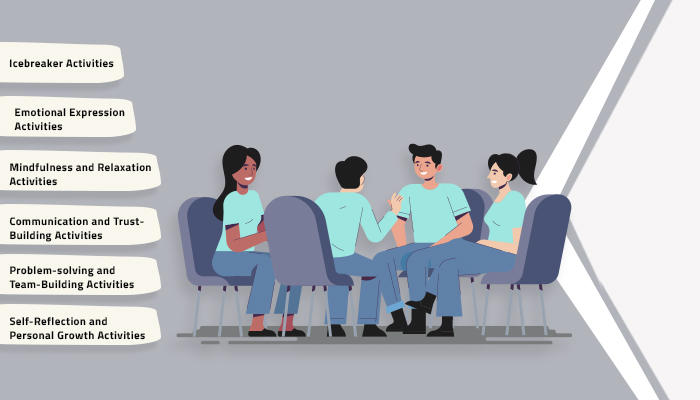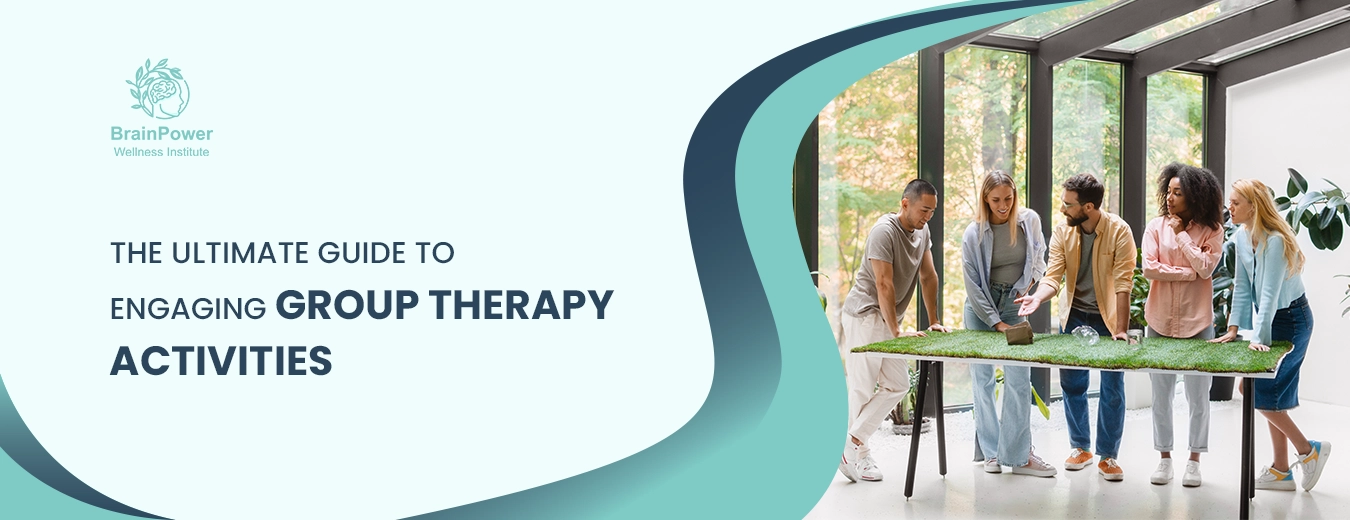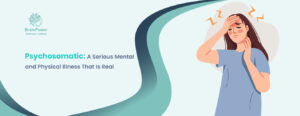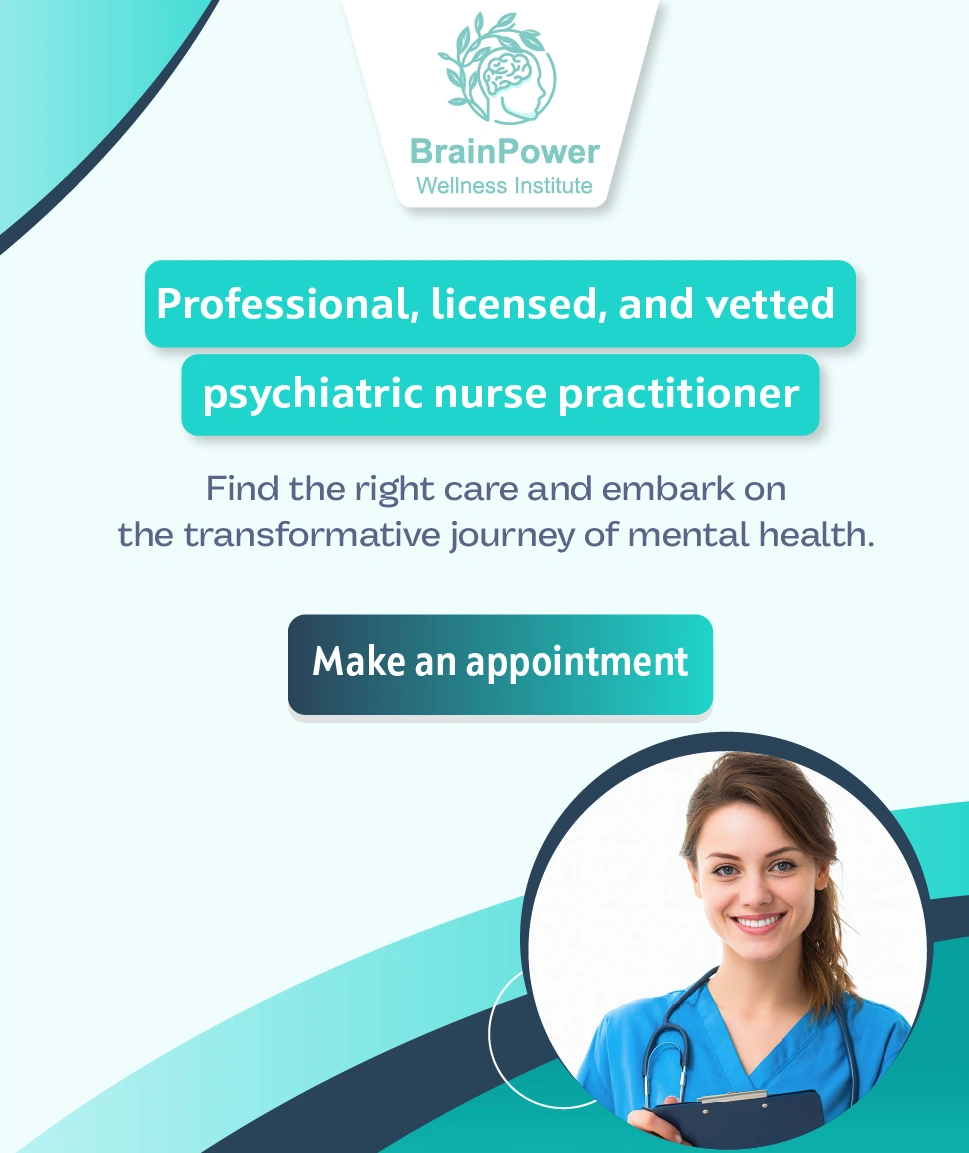Group therapy features several advantages where people can meet and discuss and recall their experiences of the same kind in a prescribed setting. It is a form of therapy, where the process is facilitated by an experienced practitioner who leads others with one or more common issues, helping people to find each other and fully recover. Group therapy activities are crucial because they help people interact, express themselves, and mingle to help the group feel whole and share as one. Different situations, including clinical environments, community centers, online platforms, and support groups, serve various purposes, making group therapy a very useful and effective model of mental health intervention.
Benefits of Group Therapy Activities
Engaging in group therapy can be highly beneficial for various reasons. Here are some of the leading benefits that make individuals adopting this style of therapy find it both satisfactory and efficient.
Mental Health Benefits
Group counseling decreases overall anxiety, depression, and stress levels. It also includes a structured format with assigned tasks such as mindfulness or art projects. One reason is that everybody loves to have some sort of belongingness, and that is why it is always very important to share good experiences to bring about positive change.
Social Benefits
Engaging in group work causes people to enhance their personalities by interacting with others, such as sharing ideas and emotions. It also enhances the functionality of interpersonal skills like communication and compassion. Communication plays a vital role in breaking isolation; thus, any teamed activity allows people to engage in communication exercises.
Emotional Benefits
Group therapies also enable an individual to express his or her emotions freely hence receiving relief and healing. Writing a journal or participating in a discussion helps eliminate feelings of loneliness and foster hope.
Goal-Oriented Benefits
Group therapy enables participants to set goals and work towards their accomplishment. It is based on goal-oriented activities including dealing with fear and increasing one’s self-esteem with help from the group to keep people motivated toward a goal.
Promotes Self-Awareness
Self-reflectiveness exercises make the participants understand common behaviors and aspects that need a change in mental health.
Implements ability to solve problem lessons
Collaborative tasks improve the aspect of creativity in solving tasks that arise. As members of the group work to solve problems, they acquire better ways of handling the challenges they encounter.
Encourages Accountability
Participants have to share goals and continually update the group on their progress to retain the participants on the right path.
Builds Emotional Resilience
Resilience-building activities help to prepare participants for stress and adversity and help to instill a positive outlook on life.
Therapeutic group activities themselves are a blueprint for better psychological well-being, social belonging, and self-development all in one allowing individuals to be competent.
Different Types of Group Therapy Activities
Group therapy can be very satisfying for participants because the effect is cumulative; here are six approaches to such activities:
1. Icebreaker Activities
Icebreakers reduce tension and make the atmosphere more friendly since people begin to know each other. Basic fun activities allow participants to cut down on stress and establish rapport, preparing them for more serious interventions.
Examples:
- “Two Truths and a Lie”: This activity requires participants to give two truths and one lie about themselves so that other people can know about them.
- Fun Facts Sharing: Each member tells something about himself and this dissolves ice and creates togetherness among the team.
2. Mindfulness and Relaxation Activities
Thus, mindfulness introduces several benefits to a person’s life: it helps release stress and anxiety and provides emotional stability. Besides, they assist the participants in focusing on the present time.
Examples:
- Guided Meditation: The facilitator guides participants to put their minds on their breathing and to start imagining the calmness of a lake.
- Deep Breathing Exercises: Methods for deep and slow respiration to bring down stress levels in the body.
3. Communication and Trust-Building Activities
Such activities contribute to the group members’ skills in using protected speech and increase the level of trust among the participants.
Examples:
- Trust Fall: One member will try and fall backwards knowing that others will catch them thus enhancing teamwork.
- “I Feel” Statements: Participants describe how they feel about a particular situation, which establishes open and satisfactory discussion.
4. Emotional Expression Activities
Art platforms allow for the exorcism of emotions and allow participants to gain a greater insight into what they feel and let out.
Examples:
- Art Therapy: Scribbling or creating a special picture to convey feelings.
- Journaling Sessions: The technique of putting down feelings and ideas on paper as a way to deal with feelings.
5. Problem-solving and Team-Building Activities
These activities promote interactions and build skills such as critical thinking and perseverance when people are put in a collective group and probed problem-solving activities.
Examples:
- Escape Room Scenarios: Small groups work through puzzles to “get out” of an artificial confined setting.
- Survival Scenarios: Teams choose the item necessary for survival which fuels discussions and fosters team spirit.
6. Self-Reflection and Personal Growth Activities
Members are provided with opportunities to learn about themselves and their behaviors so that they can come up with new agendas for change.
Examples:
- Vision Board Creation: Constructing visual boards on individual visions and objectives.
- Strengths and Weaknesses Assessment: Explaining traits and characteristics and exploring the growth of the individual.
Therapeutic group activities offer a variety of exciting techniques that improve and foster mental and emotional health and could often transform normal therapeutic experiences into richer kinds of therapy.

Activities in an Age-Specific Group Therapy
Different kinds of activities can be beneficial in group therapy depending on the age of the members. Below is a breakdown of Children’s, Adolescent’s, Adults and Seniors most relevant activities.
1. For Children:
Children’s interventions include structured and unstructured play and the use of toys and art for them to display feelings, interact, and control their behavior.
Examples:
- Feelings Charades: The use of emotions to learn them and perform in front of the class.
- Art Projects: Art to convey an individual emotion through illustration.
2. For Adolescents:
Teenagers’ therapy, in particular, focuses on interpersonal communication, self-esteem, and management of such challenges as peer pressure and anxiety.
Examples:
- Role-Playing: Role plays like handling a conflict situation.
- Group Discussions: Discussions on topics such as bullying or stress-related issues.
3. For Adults:
Such group activities among adults have a stress-relieving effect and promote personality development.
Examples:
- Mindfulness Meditation: Techniques to reduce anxiety.
- Goal-Setting Workshops: Performance of tasks related to goal setting- personal or professional.
4. For Seniors:
For seniors, activity prevents them from getting bored hence self-isolating themselves. While, for the mind, it fetches engagement hence reducing the chances of it getting idle.
Examples:
- Reminiscence Therapy: Sharing memories to boost connection.
- Gentle Movement: Seated yoga or stretching for easing up the body and mind.
These activities add value to therapy by catering to the age requirements of the patients as well as boosting mental health.
Effective Group Therapy Techniques
There are several approaches to group therapy that facilitate interaction, promote self-identity, as well as, improve treatment processes. Here’s a look at three effective group therapy techniques that foster growth and healing:
1. Active Listening and Feedback
In active listening, participants are obligated to be attentive listeners and give considered replies. Because group work enables the members to interact with one another it fosters trust, understanding, and proper communication with other group members. Feedback is not a criticism; it positively educates the self and others.
“Reflective Listening”:
Facilitators restate what the participants said using their own words to ensure comprehension, as well as for analysis.
2. Role-Playing and Simulation
Role-play enables attendees to see how they will handle issues in real-life scenarios.
Conflict Resolution Scenarios:
Attendees mimic usual interpersonal clashes, for instance, work-related stress, and learn to communicate appropriately.
3. Guided Visualization
Relaxation visualization is similar to other relaxation techniques in that it enables participants to deal with stress and anxiety by using a combination of mental pictures that produces positive feelings. It helps foster attention and emotional self-control.
Calm Place Visualization:
The practitioner leads the participants to think of a quiet environment; this helps in the lowering of stress thus making the participants safe.
Tips for Facilitating Group Therapy Activities
Another essential area of focus is how group therapy is facilitated – or led – by the therapist. Here are some valuable steps to improve your strategy:
Drawing Lines and Rules
Set objectives for identifying how the group will behave when interacting with each other to avoid violations of personal space. Develop an environment that will give participants the confidence to express themselves fully.
Encouraging Participation
Promote equality during discussion, so that none of the members can impose their opinions and ideas only. One has to begin with interesting icebreakers to help reduce the tension for the participants.
Managing Conflict and Touchy Matters
To ensure that students within the group do not quarrel unnecessarily with running the projects, one should know how to approach the conflicting party with a positive resolution that will favor both parties. Be careful with sensitive issues, yet enable participants to complain in case they are uncomfortable.
Evaluating Progress
Come in with the frequency that allows recognizing skills’ development as well as both individual and group achievements through class discussions and invaluable critiques. It is also best to avoid being rigid with the implementation of an activity and allow participants the chance to grow by changing what they do if necessary.
Examples of Group Therapy Activity Plans
| Goal | Day | Activity |
| Mental Health Improvement | Monday | Mindfulness meditation and discussion |
| Wednesday | Emotional expression through art therapy | |
| Friday | Group sharing of coping strategies | |
| Social Skills Development | Tuesday | Role-playing social scenarios |
| Thursday | Team-building exercises (e.g., trust falls) | |
| Saturday | Group games to foster interaction | |
| Personal Growth | Monday | Goal-setting workshop |
| Wednesday | Self-reflection journaling | |
| Friday | Vision Board Creation |
Customizing Activities to Group Needs
| Customization Approach | Description |
| Assess Group Dynamics | Conduct assessments to identify participants’ needs. |
| Adapt Activities | Modify exercises based on feedback and progress. |
| Incorporate Interests | Include hobbies or interests to boost engagement. |
Free and Easy-to-Implement Group Therapy Activities
The cost of group treatment doesn’t have to be high. Here are some free or inexpensive activities and suggestions for online group therapy that can improve participant connection and involvement.
Low-Cost or No-Cost Activities
These activities are simple to use in group therapy settings and don’t cost a lot of money. They build relationships, stimulate involvement, and support members’ emotional health.
Group Discussions
Discussions in groups are candid exchanges of ideas on certain subjects, such as coping mechanisms or mental health issues. Establish guidelines that promote polite sharing and attentive listening.
Mindfulness Sessions
Meditation or mindfulness activities under guidance can be a part of mindfulness sessions. Utilize free applications or internet tools to help lead the session.
Journaling Exercises
Participants can write about their experiences or thoughts using journaling prompts. Set aside time for sharing reflections and distribute the prompts beforehand.
Art Therapy with Common Materials
Using basic supplies like paper and pencils for coloring or sketching is known as art therapy using common materials. Encourage people to share their artwork and use it as a means of expressing their feelings.
Sessions of Storytelling
Participants can share personal tales or experiences pertaining to a theme, such as conquering obstacles, during storytelling sessions. Give each participant a certain amount of time to speak while the others engage in active listening.
Ideas for Online Group Therapy Activities
People can effectively interact and form meaningful relationships through online activities. Here are some interesting suggestions for leading virtual group therapy sessions.
Virtual Support Circles
Using video conferencing tools, virtual support circles establish a secure environment for support and sharing. Establish weekly conversation themes or subjects.
Online Game Nights
Participants in online games play virtual games that encourage cooperation and communication. Play games like Pictionary or trivia on free platforms.
Guided Visualization Sessions
Use video calls to practice visualizing. Guide participants with soothing scripts or online movies.
Resource Sharing
Participants are encouraged to share useful mental health-related articles, films, or tools through resource sharing. Establish an online forum or shared document to facilitate continuous resource sharing.
Without having to worry about exorbitant fees, these exercises can promote support, involvement, and connection in group therapy settings.

To sum up,
Group therapy is a potent method of treating mental illness since it offers a safe environment for people to connect and exchange stories. Through a variety of activities, participants experience profound mental, emotional, and social benefits, including better communication skills, a deeper feeling of community, and improved emotional expression. To begin your path to better mental health, look into Brainpower Wellness Institute’s group therapy options. To encourage healing and connection in your life, take the first action right now.
Related Articles:
Top 20 Icebreakers for Group Therapy
Top 7 Group Therapy Games for Teens




